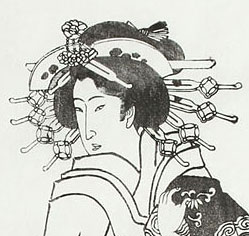

Ireki: (入木)
|
 Bunrô (文浪 active c. 1800-1810) is known only by his geimei or art name. He was apparently a pupil of
Ippitsusai Bunchô (active c. 1765-92), but later came under
the influence of Kitagawa Utamaro (1753-1806).
Bunrô (文浪 active c. 1800-1810) is known only by his geimei or art name. He was apparently a pupil of
Ippitsusai Bunchô (active c. 1765-92), but later came under
the influence of Kitagawa Utamaro (1753-1806).
Very few of Bunrô's prints have survived, mostly those in the Utamaro style and in aiban format. The image illustrated on the right is signed Bunrô ga and was published by Ezakiya Kichibei. Designed in the manner of Utamaro, it depicts a young beauty standing behind a stylish young man dressed as a mendicant monk called a komusô ("priest of nothingness"). Behind him can be seen a large basket-shaped rush hat (tengai) and wooden flute (shakuhachi) as played by the Fuke sect of Zen Buddhism. Komusô were closely associated with the samurai class; treated with respect, they had permission to travel freely and without obligation to reveal their faces hidden under rush hats. The dress of a komusô was, however, a convenient disguise used by common citizens for secret trysts or escape journeys. Thus the couple in this double portrait may be involved in an illicit relationship, either a samurai visiting a courtesan or a couple whose love is in conflict with family or societal obligations.
 This impression is of particular interest because it shows a repair to the key block. A plug (called ireki or "inserted wood": 入木)
was added, perhaps to compensate for damage — two edges of the plug can be seen in the rush hat just to the right of the face of the male
figure (see the illustration on the left). Once the ireki was in place, it would be recarved for the new design element, the greatest challenge being to join up the lines in the plug with those that continued beyond the plug in the earlier design.
This impression is of particular interest because it shows a repair to the key block. A plug (called ireki or "inserted wood": 入木)
was added, perhaps to compensate for damage — two edges of the plug can be seen in the rush hat just to the right of the face of the male
figure (see the illustration on the left). Once the ireki was in place, it would be recarved for the new design element, the greatest challenge being to join up the lines in the plug with those that continued beyond the plug in the earlier design.
Ireki editions are known from at least the early eighteenth century. Repairs of this kind were made when an older print design was popular enough to justify the effort for continued sales or when damages occurred early in the printing of an edition, making it necessary for the publisher to repair the block to recover or exceed his financial investment. Bunrô's impression happens to be a late one, as it shows general wear to the key block (that is, the key lines are not sharp and unbroken like those expected in an early impression).
 Ireki plugs were also used to make changes unrelated to block damage, for example, to deliberately change the faces or figures in a print.
Publishers would update designs for new productions of kabuki plays by altering the physiognomies of the actors or the
inscriptions related to roles or play titles. Privately issued erotic subjects were sometimes plugged with new figures or design elements
to make the prints less explicit and thus more commercially viable. Popular courtesans from an earlier period had their faces replaced by
their more current sisters, although these "portraits" represented not actual likenesses but revised idealizations drawn in a
more up-to-date manner.
Ireki plugs were also used to make changes unrelated to block damage, for example, to deliberately change the faces or figures in a print.
Publishers would update designs for new productions of kabuki plays by altering the physiognomies of the actors or the
inscriptions related to roles or play titles. Privately issued erotic subjects were sometimes plugged with new figures or design elements
to make the prints less explicit and thus more commercially viable. Popular courtesans from an earlier period had their faces replaced by
their more current sisters, although these "portraits" represented not actual likenesses but revised idealizations drawn in a
more up-to-date manner.
The illustration below shows a detail from an recut early 20th-century block for a design by Utagawa Kunisada (1786-1865). Here, the face of the courtesan has been replaced, with notable skill. The square ireki plug, which is not glued but rather dropped snuggly into the vacant space left behind by the removed head, joins up well with the lines outside the plug (red arrows). In fact, a modern restrike from the block shows little evidence of the ireki (see the detail immediately above), which typically results in "line breaks" at the meeting points of the ireki and original carved lines. It is possible that damage to the block was the reason for the ireki, as there is a vertical crack due to warping or expansion of the wood that runs the length of the block and can be seen on both the front and back. In the detail below, the crack is visible above and below the ireki (blue arrows), so the split ran through the face in the original design. © 1999-2001, 2012 by John Fiorillo

BIBLIOGRAPHY
- Keyes, Roger: Japanese Woodblock Prints: A Catalogue of the Mary A. Ainsworth Collection. Oberlin: Allen Memorial Art Museum, 1984, pp. 108-113.
- Lühl, Hendrick: "Ireki in Osaka actor prints," in: Andon nos. 72-73 (John Fiorillo and Peter Ujlaki, eds.), 2002, pp. 65-94.
- Schweitzer, Paul: "How did these girls lose their heads? Reissues of 18th century pillar prints with reengraved heads," in: Andon, Vol. 6, no. 24, 1986, pp. 104-106.
Viewing Japanese Prints |